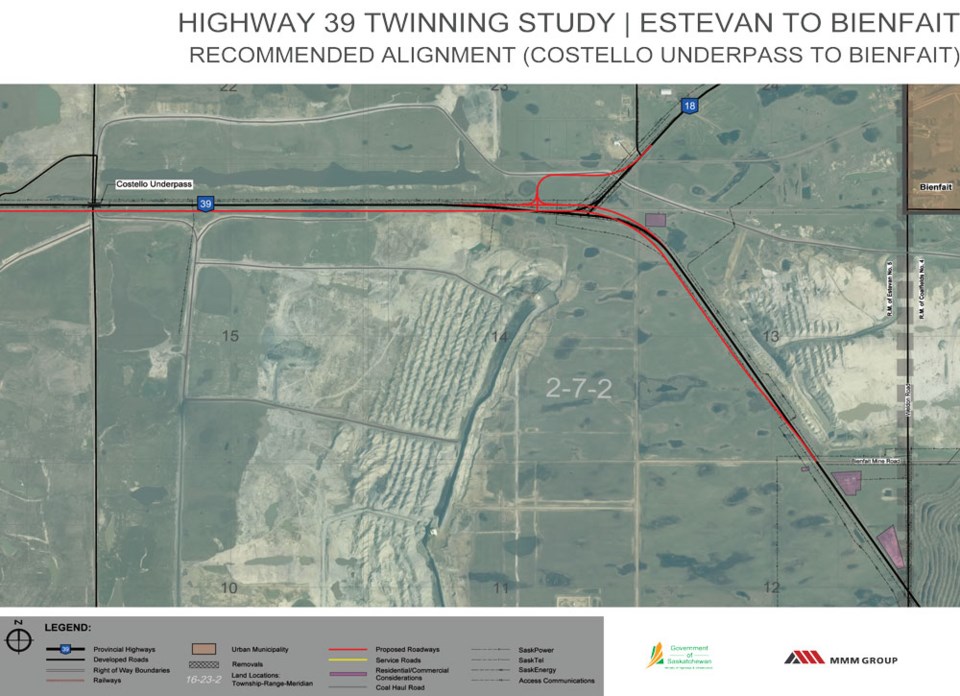The twinning of Highway 39 between Estevan and Bienfait has begun to take shape, and it’s the detailed work that locals will be waiting to see next.
Representatives from the Ministry of Highway and Infrastructure were in Bienfait Feb. 10 presenting the preferred alignment for the planned twinning of Highway 39 east of Estevan. The public open house displays at Weldon School also indicated what has been called Phase 2 of the highway twinning plans, with drawing showing a pair of options for potential road work from Bienfait to North Portal and the U.S. border.
At the open house, the aerial images of the highway showed the preferred plan would run the two divided eastbound lanes to the south of the existing highway.
East of Estevan, Highway 39 does split, running divided for about two kilometres, and the preferred option as presented would see the south lane of that section removed in places and relegated to a service road for access to properties along the current highway. Access to that service road will come from the Shand Access Road.
Matthew Stephenson, senior project manager, said that decision was made because while the road is divided, there isn’t enough space for that section to be seen as any sort of advantage.
One immediately noticeable change is the intersection design by Highway 39 and 18, which was shown to become a 90-degree turn.
“One of the main things we look at is the traffic volume and the collision history at the existing intersection,” said Stephenson about the intersection of Highways 39 and 18.
He noted the current intersection sits at a “skew” or an angle that isn’t 90 degrees and that’s something they have altered in this preferred option.
“It’s never ideal to have an intersection askew like that, so whenever you’re doing a major infrastructure project, such as twinning, you’re looking at locations like this that are out of skew, which aren’t ideal because it prohibits your sight lines at the intersection. You’re looking for what you can do to bring it up to a common standard of a 90-degree intersection.”
They did consider other options like a grade-separated interchange, but Stephenson said “ultimately the traffic volumes and collision history didn’t justify it.”
The ministry has said the intersections being constructed on the heavy-truck bypass around Estevan have been designed with the potential for future alterations, but at this time Stephenson said that isn’t a concern at the corner of Highway 18 and 39.
“You’re comparing it to the east terminal of the truck bypass that we’ve identified, and we’re trying to protect land for future interchanges. This location, based on the traffic volumes, we aren’t right now.”
There is expected to be a left turn lane on Highway 39 for traffic turning north on Highway 18, and there are ramps onto and off the highway shown in the current drawings. Those finer details will be more fully fleshed out in the detailed design phase.
Looking at traffic volumes, Stephenson noted that about two-thirds of the traffic on Highway 39 east of Estevan turns onto Highway 18 or comes from Highway 18. The other third comes from further down Highway 39 to the U.S. border.
Environmental and geological assessments have been completed along the highway. The geological survey found the soil type was very suitable to the construction of subgrade. The environmental assessment found seven rare or endangered species in the area, four plant and three animal species.
Leopard frogs were found in the area and mitigation plans are being determined. Clearing and construction activities will take into consideration nesting birds, and bird surveys will be completed prior to construction.
Ministry spokesperson Joel Cherry said the environmental side is just one factor that needs to be taken into account. Co-ordinating with the Ministry of Environment regarding those concerns, Highways must also work closely with utility providers who have infrastructure above or below the ground, including SaskPower, SaskTel, SaskEnergy and Access Communications.
The province will also have to purchase land in order to build the additional highway lanes.
The functional planning study is expected to be complete in April, and this summer detailed design work will begin.
“At this point we’re looking to get feedback on both of those. Timelines are difficult to talk about right now. They’re subject to budget, obviously,” said Cherry, regarding when construction may be expected.
Last week’s open house also unveiled proposed options for twinning the highway from Bienfait to North Portal and the U.S. border. The Ministry is accepting feedback on how to proceed with that section, which they have called Phase 2. The options last week were presented as adding lanes either to the north or south side of the current highway, pointing out properties and structure that may limit those options in some places.
The Ministry will present the preferred option for that section during an open house in April.




